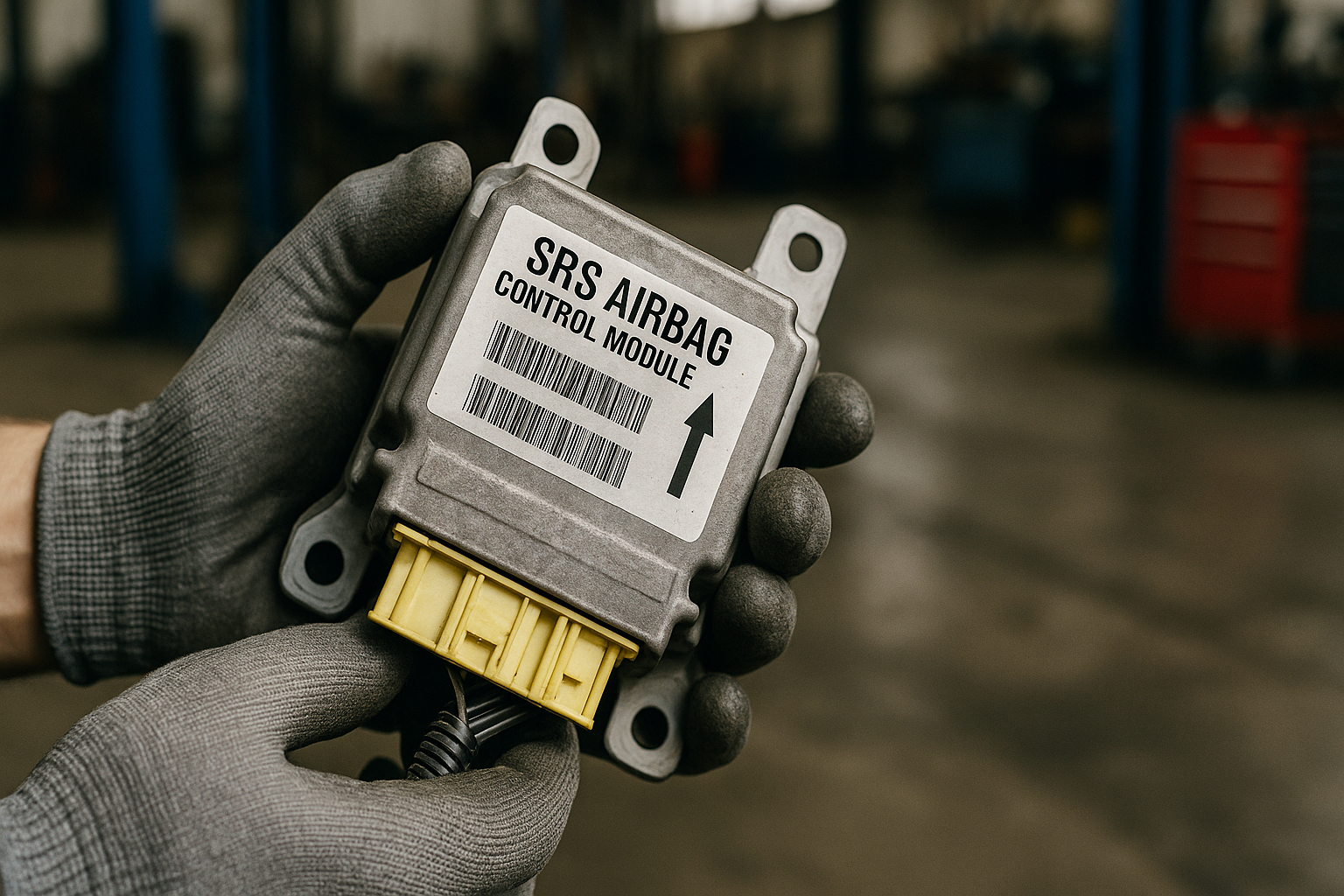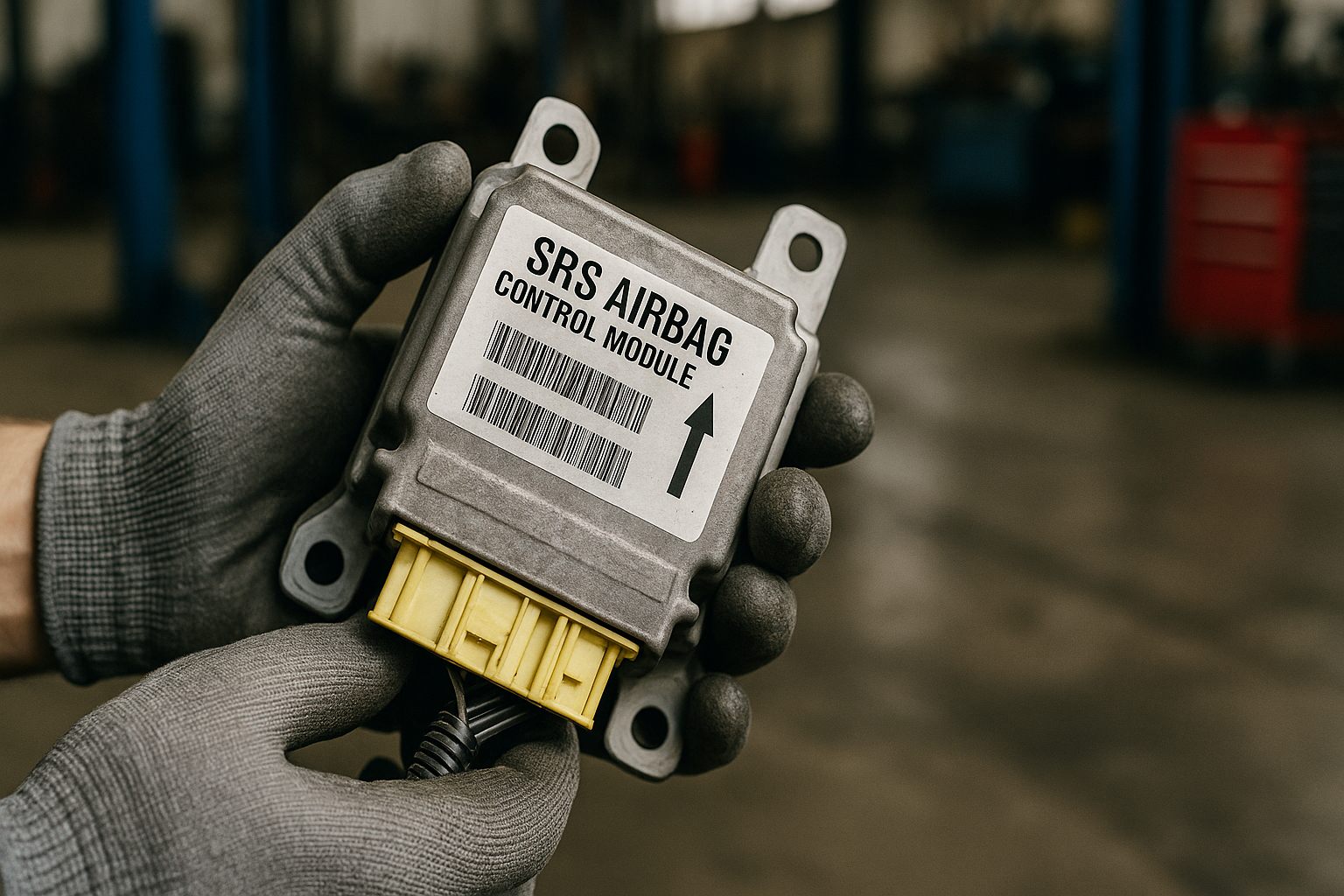How to Remove the SRS Module, 2020-2025 Nissan Sentra | MyAirBags
Last updated:


When a small box controls a big safety story
A modern Nissan Sentra hides a lot of safety engineering in one compact controller—the SRS airbag control module under the center console. If you’ve had a collision or the airbag light is on, removing that module so it can be reset and returned is often the quickest, most affordable path back to a healthy restraint system. MyAirbags specializes in resetting your original SRS module so it’s plug-and-play when it comes back—no hunting for used parts or paying dealer coding fees. Typical resets are completed within about 24 hours of arrival, which is why shops and DIYers ship to us every day.
MyAirbags operates out of the Atlanta area (Buford, GA) and has built a simple mail-in workflow: place your order, box your part, print/receive a shipping label, and we’ll text or email you when it’s ready. You can even ship seat belts in the same box for rebuild if your pretensions deployed.
Safety first (read this before you touch anything)
-
Disconnect the battery before working on airbag/SRS parts.
-
Wait a few minutes after disconnecting (MyAirbags guidance: disconnect positive and wait at least ~3 minutes before unplugging harnesses).
-
Work on a level surface; keep keys away from the vehicle while SRS is disconnected.
-
Handle yellow SRS connectors with care; don’t probe them with metal tools.
Tools & supplies
-
10 mm socket & ratchet
-
T20 Torx driver/bit
-
Plastic trim tool or small flathead (for clips—use gently)
-
Painter’s tape/markers (label plugs)
-
Small container for screws
Step-by-step: Remove the SRS module on a 2020–2025 Sentra
The outline below follows the MyAirbags how-to video so you can match each step on your car.
1) Power down the vehicle
-
Open the hood; disconnect the negative battery cable, then the positive.
-
Wait a few minutes before unplugging any SRS connectors.
2) Prepare the shifter & console
-
Pop the small plastic trim cap at the shifter.
-
Press the white release to move the shift lever (you may need to press the brake or use the release tab).
-
Slide the sleeve down; remove the small metal retaining clip under spring tension at the knob, then lift the knob off. (Mind the spring/clip—don’t lose it.)
3) Loosen side panels
-
In the passenger footwell, slightly separate the lower side panel to reveal a T20 screw; remove it.
-
Repeat on the driver’s side.
4) Access from the rear
-
Fold up the rear armrest.
-
Use a trim tool to pop the rear console clips and disconnect the rear accessory plug (press the clip to release).
-
Remove the two 10 mm bolts—one on each side—holding the rear of the console.
5) Lift the front console section
-
From the front seats, get a firm grip and pull the center console upward (it’s clipped).
-
Unplug all connectors you see as you lift (push-start switch, cup-holder harness, front switch bank—usually several small plugs). Label them if helpful.
6) Remove the Torx screws at the shifter area
-
Remove two T20s at the front of the console and two T20s beneath the shifter trim. Then lift the large console panel straight up.
7) Expose and remove the SRS module
-
With the console out, the airbag control module is visible between the seats.
-
Unplug the SRS connectors first (lift the yellow lever/lock, then pull the plug straight out).
-
Remove the three 10 mm bolts holding the module (typically two on passenger side, one on driver side).
-
Lift the module out. (Most Nissan SRS modules are a boxy unit; Nissan part numbers often start with 98820-xxxxx.)

What to ship (and how)
-
SRS module in anti-static or padded wrap
-
Optional: seat belts/pretensioners from the same incident (you can combine them in one order/box)
-
Include order slip/contact info; print or use the emailed FedEx label (many Walgreens/Dollar General/FedEx stores can print for you).
Reinstall notes (after reset)
-
Reinstallation is the reverse of removal.
-
Bolt the module down first, then connect the harnesses; reconnect the battery last.
-
Verify all console plugs are reconnected (start/stop, switch banks, rear power).
-
Clear any stored crash data/SRS codes and confirm the airbag light runs its self-test and goes out
Reset vs. replace: what makes sense for Sentra owners?
-
Reset your original: Keeps VIN/coding, avoids the dealer programming loop, and is far cheaper than buying new. Most jobs are plug-and-play on return.
-
Replace: If your module is physically damaged or the board’s flooded/burned beyond recovery, replacement may be required—and must match the exact part number (e.g., Nissan’s SRS modules typically start with 98820-xxxxx)
Why MyAirbags
-
SRS specialists: Airbag module resets and seat belt rebuilds are our daily work across makes and models.
-
Fast turnaround: We target about 24 hours in-house for SRS resets so you’re not stuck waiting.
-
Plug-and-play: Your original module comes back ready to install—no dealer coding in typical accident/crash-data cases.
-
Simple logistics: Online order → label → ship; we keep you posted and can assist with label printin
Back to a Safe, Ready-to-Drive Sentra (Do It Once, the Right Way)
If you’ve followed the steps to expose and remove the SRS control module on a 2020–2025 Nissan Sentra, you’ve already done the most important part: handling the system safely and in the right order. Disconnecting the battery first, unplugging the harnesses before unbolting the module, and reversing that sequence on install (bolt down then connect) isn’t just “by the book”—it prevents accidental deployments and protects every other SRS component you’re counting on.
From here, you’ve got two paths. You can chase a replacement control unit that exactly matches your part number (on most Nissans it begins with 98820-xxxxx), or you can reset your original module. The replacement route often means hunting the precise part, paying a premium, and risking coding or compatibility surprises. Resetting your own unit keeps your vehicle’s original programming intact and, in most cases, gets you back on the road faster and cheaper—plug-and-play once it returns.
This is where MyAirbags makes the difference. Their Airbag Module Reset service clears crash data and restores the module to factory condition, typically with a 24-hour turnaround once received. That means less downtime, no guessing on part numbers, and no hassle re-learning your car’s configuration. If your Sentra’s belts deployed or locked, you can add seat belt pretensioner/webbing repair to the same box and get everything handled in one shot—also with rapid turnaround using OEM-grade parts.
A few last safety points before reinstall:
-
Battery first, every time. Disconnect before removal and reconnect only after the module is bolted in and the entire SRS is re-assembled. Many Nissan service notes and MyAirbags guides emphasize this sequence.
-
Flat ground only. Don’t work on the SRS with the vehicle on a jack or lift; some systems can interpret chassis angle changes during service as an event.
-
Harness & fasteners. Inspect connectors for bent pins or corrosion and torque the module’s three 10 mm boltsfirmly—secure mounting is part of proper crash sensing. (On Sentra, the module sits under the center console.)
-
Seat belts matter. If the light persists after reinstall, scan for codes. A post-accident SRS light is often a belt pretensioner or wiring issue, not just the module. MyAirbags can service belts in the same order.
When you add it up—correct removal technique, validated crash-data clearing, fast logistics, and the option to rebuild belts in the same pass—the repair-and-return approach is the practical path for most Sentra owners. You avoid the uncertainty of used parts, the expense of new ones, and the delay of coding. You keep your original module, professionally reset and tested, and you reinstall it with the confidence that the job was done safely and correctly.
Ready to finish strong? Start your MyAirbags SRS Module Reset now, add any seat belt services you need to the same order, and get your Sentra’s safety system back to 100%—quickly, cleanly, and without guesswork.

 myairbags.com
myairbags.com 888-779-9029
888-779-9029

